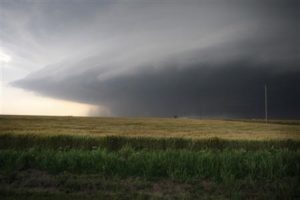
Illinois appeared to receive the brunt of the damage, as seven counties were declared a disaster area by Gov. Pat Quinn. Illinois is also where all six deaths occurred.
According to the New York Times, a twister killed an 80-year-old man and his 78-year-old sister on their farm outside New Minden, Ill., about 50 miles east of St. Louis, tossing the man into a field about 100 yards from the home. His sister’s body was recovered under a pile of rubble, according to the Washington County coroner’s office. Three people were killed in southern Illinois in Massac County, while another was killed in Washington, Ill., one of the hardest-hit towns.
“Devastation. Sadness. People that lost everything,” Washington Mayor Gary Manier said on CNN.
It was around 11 a.m. Sunday when the storm struck Washington, destroying homes that luckily were mostly empty because most of town’s 10,000 residents were at church.
A CNN iReporter, Anthony Khoury, who filmed the tornado ripping through his neighborhood, said, “It was complete destruction. There are people in the streets crying.”
There were at least 80 reports of tornadoes, but Bill Bunting of the National Weather Service’s Storm Prediction Center in Norman, Okla., said the actual number will likely be in the 30 to 40 range because some storms get reported more than once.
Peoria resident Michelle Crumrine said the winds swept away her home and everything in it.
“A lot of people have a pile of rubble still, and I don’t have anything,” she said. “It’s gone. I don’t know where it went.”
Steve Bucher of Washington told CNN he lost everything except his wife, his shoes and a single dollar bill in his wallet.
“The sky was just rumbling for 20 minutes,” he said. “I told my wife I’ve just never heard anything like this in my life.”
Soon after his wife begged him to go downstairs into their basement, he said, “Within 30 seconds, the house was literally vibrating from the direct hit of this funnel cloud.”
“Next thing we know, things are cracking, and glass breaking and furniture came around the corner, missed us even though it came down the hallway where we were,” he said.
“I think my attitude was in the next minute and a half, we’re either going to be in heaven, we’re going to be in the hospital or we’re going to walk out of here. Completely in the Lord’s hands which one of those three things was going to happen,” he said.
In Indiana, more than 160,000 people are without power across the state, according to John Erickson, a spokesman for the Indiana Department of Homeland Security.
The storm even affected the NFL game between the Chicago Bears and Baltimore Ravens, as officials delayed the game for almost two hours and warned spectators to leave the stands at Soldier Field and head for covered areas.
“The rain started coming, the skies got black, the wind was insane, and they evacuated us to underneath the concrete concourse,” said Jim Arnold, who was at the game with his 11-year-old daughter.
“We’ve been through 15-degree-below weather and winds, but never anything like this,” Arnold said. “The winds gusted at 70 mph, and the winds and the rain were horizontal and everybody was running. It was just crazy.”
After the storm passed, the Bears went on to please the local fans with a victory.
According to CNN meteorologist Karen Maginnis, the storms came later in the year than some might have expected.
“The primary time for tornadoes, as we well know, is springtime. Then we see a second high that comes in the fall,” she said. “Is this late? It is rather late, because the temperatures have been very warm.”
“On the backside of that, temperatures are dramatically cooler. So that cold air is filtering in behind it, warm air out ahead of it,” she said. “And … we get some twisting motion in the atmosphere. And that’s why we see this tornadic activity.”


